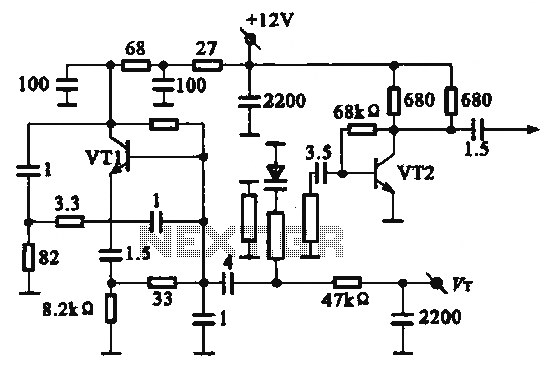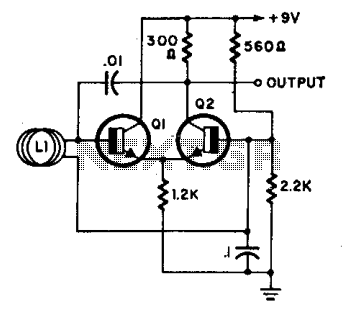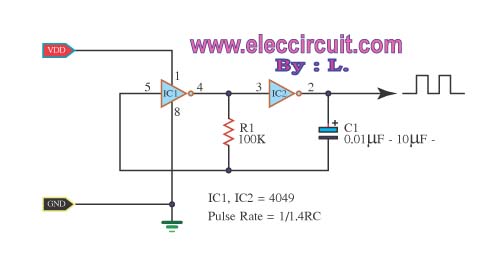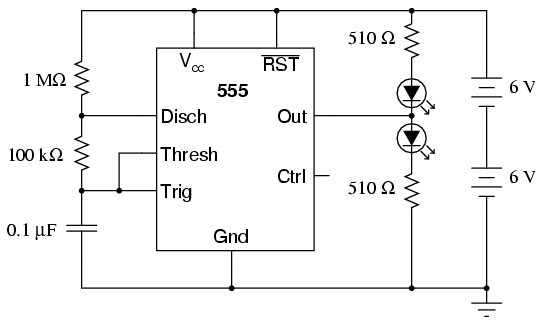
Tuned-base Armstrong oscillator

The circuit depicted in view (D) satisfies all three criteria for an oscillator: (1) amplification, (2) a frequency-determining device (fdd), and (3) regenerative feedback. This schematic represents a tuned-base oscillator, as the fdd is located in the base circuit. If the fdd were situated in the collector circuit, it would instead be classified as a tuned-collector oscillator. The circuit illustrated is fundamentally an Armstrong oscillator. When VCC is supplied to the circuit, a small amount of base current flows through R2, establishing the forward bias on Q1. This forward bias enables collector current to flow from ground through Q1, R1, and L1 to +VCC. The current passing through L1 generates a magnetic field that induces a voltage in the tank circuit, with the voltage being positive at the top of L2 and C1. At this moment, two processes occur: first, resonant tank capacitor C1 charges to this voltage, storing energy in the tank circuit; second, coupling capacitor C2 transmits the positive signal to the base of Q1. With a positive signal at its base, Q1 increases its conduction. As Q1 conducts more, additional current flows through L1, leading to a larger voltage being induced into L2 and a stronger positive signal being fed back to the base of Q1. During this time, the frequency-determining device accumulates more energy, and C1 charges to the voltage induced into L2. The transistor continues to increase its conduction until it reaches saturation. At saturation, the collector current of Q1 reaches its maximum value and cannot increase further. With a steady current flowing through L1, the magnetic fields stabilize, and no voltage is induced into the secondary. In the absence of external voltage, C1 acts as a voltage source and begins to discharge. As the voltage across C1 diminishes, its energy is transferred to the magnetic field of L2. Next, consider C2. The coupling capacitor C2 has charged to a voltage similar to that of C1. As C1 discharges, C2 also discharges. The primary discharge path for C2 is through R2. As C2 discharges, the voltage drop across R2 counteracts the forward bias on Q1, causing the collector current to decrease. This reduction in collector current results in the collapse of the magnetic field in L1. The collapsing field induces a negative voltage in the secondary, which is coupled through C2, making the base of Q1 more negative. This process represents regenerative action, continuing until Q1 is driven into cutoff. When Q1 is cut off, the tank circuit continues to oscillate, or "flywheel." The flywheel effect not only generates a sine-wave signal but also assists in maintaining Q1 in the cutoff state. Without feedback, the oscillations of L2 and C1 would dampen after a few cycles. To ensure a constant amplitude of the output signal, regenerative feedback is provided to the tank once per cycle: as the voltage across C1 reaches maximum negative, C1 discharges toward 0 volts while Q1 remains below cutoff. C1 continues to discharge past 0 volts, becoming positively charged. The tank circuit voltage is again coupled to the base of Q1, making the base voltage positive and allowing collector current to flow. This collector current establishes a magnetic field in L1, which is coupled into the tank. This feedback action replenishes any lost energy in the tank circuit and drives Q1 toward saturation. After reaching saturation, the transistor is once more driven into cutoff. The operation of the Armstrong oscillator can be summarized as follows: Power applied to the transistor facilitates energy transfer to the tank circuit, inducing oscillation. Once per cycle, the transistor conducts briefly (class C operation) to return sufficient energy to the tank, ensuring a consistent amplitude output signal.
The Armstrong oscillator circuit is characterized by its simplicity and effectiveness in generating oscillations. The key components include the transistor (Q1), the resonant tank circuit formed by L1 and C1, and the coupling capacitor (C2) that provides the necessary feedback for sustained oscillation. The resonant frequency of the oscillator is determined by the values of L1 and C1, which can be adjusted to achieve the desired frequency of operation. The regenerative feedback mechanism is critical for maintaining oscillation, as it ensures that energy lost during each cycle is replenished, preventing the oscillations from dying out.
In practical applications, the Armstrong oscillator can be used in various radio frequency (RF) applications, such as signal generation in transmitters and as a local oscillator in receivers. The design can be further optimized by selecting components with appropriate voltage ratings, current capacities, and frequency responses to ensure reliable operation in the intended application. Additionally, the circuit may be enhanced with additional stages of amplification or filtering to improve signal quality and stability. Overall, the Armstrong oscillator remains a foundational circuit in electronic design, illustrating the principles of feedback and resonance in oscillator design.The circuit in view (D) has all three requirements for an oscillator: (1) amplification, (2) a frequency-determining device, and (3) regenerative feedback. The oscillator in this schematic drawing is a tuned-base oscillator, because the fdd is in the base circuit.
If the fdd were in the collector circuit, it would be a tuned-collector oscillator. The circuit in view (D) is basically an Armstrong oscillator. Refer to figure 2-10, view (D), for the following discussion of the circuit operation of the Armstrong oscillator. When VCC is applied to the circuit. a small amount of base current flows through R2 which sets the forward bias on Q1. This forward bias causes collector current to flow from ground through Q1, R1, and L1 to +VCC. The current through L1 develops a magnetic field which induces a voltage into the tank circuit. The voltage is positive at the top of L2 and C1. At this time, two actions occur. First, resonant tank capacitor C1 charges to this voltage; the tank circuit now has stored energy. Second, coupling capacitor C2 couples the positive signal to the base of Q1. With a positive signal on its base, Q1 conducts harder. With Q1 conducting harder, more current flows through L1, a larger voltage is induced into L2, and a larger positive signal is coupled back to the base of Q1.
While this is taking place, the frequency-determining device is storing more energy and C1 is charging to the voltage induced into L2. The transistor will continue to increase in conduction until it reaches saturation. At saturation, the collector current of Q1 is at a maximum value and cannot increase any further. With a steady current through L1, the magnetic fields are not moving and no voltage is induced into the secondary.
With no external voltage applied, C1 acts as a voltage source and discharges. As the voltage across C1 decreases, its energy is transferred to the magnetic field of L2. Now, let`s look at C2. The coupling capacitor, C2, has charged to approximately the same voltage as C1. As C1 discharges, C2 discharges. The primary discharge path for C2 is through R2 (shown by the dashed arrow). As C2 discharges, the voltage drop across R2 opposes the forward bias on Q1 and collector current begins to decrease. This is caused by the decreasing positive potential at the base of Q1. A decrease in collector current allows the magnetic field of L1 to collapse. The collapsing field of L1 induces a negative voltage into the secondary which is coupled through C2 and makes the base of Q1 more negative.
This, again, is regenerative action; it continues until Q1 is driven into cutoff. When Q1 is cut off, the tank circuit continues to flywheel, or oscillate. The flywheel effect not only produces a sine-wave signal, but it aids in keeping Q1 cut off. Without feedback, the oscillations of L2 and C1 would dampen out after several cycles. To ensure that the amplitude of the signal remains constant, regenerative feedback is supplied to the tank once each cycle, as follows: As the voltage across C1 reaches maximum negative, C1 begins discharging toward 0 volts. Q1 is still below cutoff. C1 continues to discharge through 0 volts and becomes positively charged. The tank circuit voltage is again coupled to the base of Q1, so the base voltage becomes positive and allows collector current to flow.
The collector current creates a magnetic field in L1, which is coupled into the tank. This feedback action replaces any lost energy in the tank circuit and drives Q1 toward saturation. After saturation is reached, the transistor is again driven into cutoff. The operation of the Armstrong oscillator is basically this: Power applied to the transistor allows energy to be applied to the tank circuit causing it to oscillate. Once every cycle, the transistor conducts for a short period of time (class C operation) and returns enough energy to the tank to ensure a constant amplitude output signal.
Figure 2-11 🔗 External reference
The Armstrong oscillator circuit is characterized by its simplicity and effectiveness in generating oscillations. The key components include the transistor (Q1), the resonant tank circuit formed by L1 and C1, and the coupling capacitor (C2) that provides the necessary feedback for sustained oscillation. The resonant frequency of the oscillator is determined by the values of L1 and C1, which can be adjusted to achieve the desired frequency of operation. The regenerative feedback mechanism is critical for maintaining oscillation, as it ensures that energy lost during each cycle is replenished, preventing the oscillations from dying out.
In practical applications, the Armstrong oscillator can be used in various radio frequency (RF) applications, such as signal generation in transmitters and as a local oscillator in receivers. The design can be further optimized by selecting components with appropriate voltage ratings, current capacities, and frequency responses to ensure reliable operation in the intended application. Additionally, the circuit may be enhanced with additional stages of amplification or filtering to improve signal quality and stability. Overall, the Armstrong oscillator remains a foundational circuit in electronic design, illustrating the principles of feedback and resonance in oscillator design.The circuit in view (D) has all three requirements for an oscillator: (1) amplification, (2) a frequency-determining device, and (3) regenerative feedback. The oscillator in this schematic drawing is a tuned-base oscillator, because the fdd is in the base circuit.
If the fdd were in the collector circuit, it would be a tuned-collector oscillator. The circuit in view (D) is basically an Armstrong oscillator. Refer to figure 2-10, view (D), for the following discussion of the circuit operation of the Armstrong oscillator. When VCC is applied to the circuit. a small amount of base current flows through R2 which sets the forward bias on Q1. This forward bias causes collector current to flow from ground through Q1, R1, and L1 to +VCC. The current through L1 develops a magnetic field which induces a voltage into the tank circuit. The voltage is positive at the top of L2 and C1. At this time, two actions occur. First, resonant tank capacitor C1 charges to this voltage; the tank circuit now has stored energy. Second, coupling capacitor C2 couples the positive signal to the base of Q1. With a positive signal on its base, Q1 conducts harder. With Q1 conducting harder, more current flows through L1, a larger voltage is induced into L2, and a larger positive signal is coupled back to the base of Q1.
While this is taking place, the frequency-determining device is storing more energy and C1 is charging to the voltage induced into L2. The transistor will continue to increase in conduction until it reaches saturation. At saturation, the collector current of Q1 is at a maximum value and cannot increase any further. With a steady current through L1, the magnetic fields are not moving and no voltage is induced into the secondary.
With no external voltage applied, C1 acts as a voltage source and discharges. As the voltage across C1 decreases, its energy is transferred to the magnetic field of L2. Now, let`s look at C2. The coupling capacitor, C2, has charged to approximately the same voltage as C1. As C1 discharges, C2 discharges. The primary discharge path for C2 is through R2 (shown by the dashed arrow). As C2 discharges, the voltage drop across R2 opposes the forward bias on Q1 and collector current begins to decrease. This is caused by the decreasing positive potential at the base of Q1. A decrease in collector current allows the magnetic field of L1 to collapse. The collapsing field of L1 induces a negative voltage into the secondary which is coupled through C2 and makes the base of Q1 more negative.
This, again, is regenerative action; it continues until Q1 is driven into cutoff. When Q1 is cut off, the tank circuit continues to flywheel, or oscillate. The flywheel effect not only produces a sine-wave signal, but it aids in keeping Q1 cut off. Without feedback, the oscillations of L2 and C1 would dampen out after several cycles. To ensure that the amplitude of the signal remains constant, regenerative feedback is supplied to the tank once each cycle, as follows: As the voltage across C1 reaches maximum negative, C1 begins discharging toward 0 volts. Q1 is still below cutoff. C1 continues to discharge through 0 volts and becomes positively charged. The tank circuit voltage is again coupled to the base of Q1, so the base voltage becomes positive and allows collector current to flow.
The collector current creates a magnetic field in L1, which is coupled into the tank. This feedback action replaces any lost energy in the tank circuit and drives Q1 toward saturation. After saturation is reached, the transistor is again driven into cutoff. The operation of the Armstrong oscillator is basically this: Power applied to the transistor allows energy to be applied to the tank circuit causing it to oscillate. Once every cycle, the transistor conducts for a short period of time (class C operation) and returns enough energy to the tank to ensure a constant amplitude output signal.
Figure 2-11 🔗 External reference





